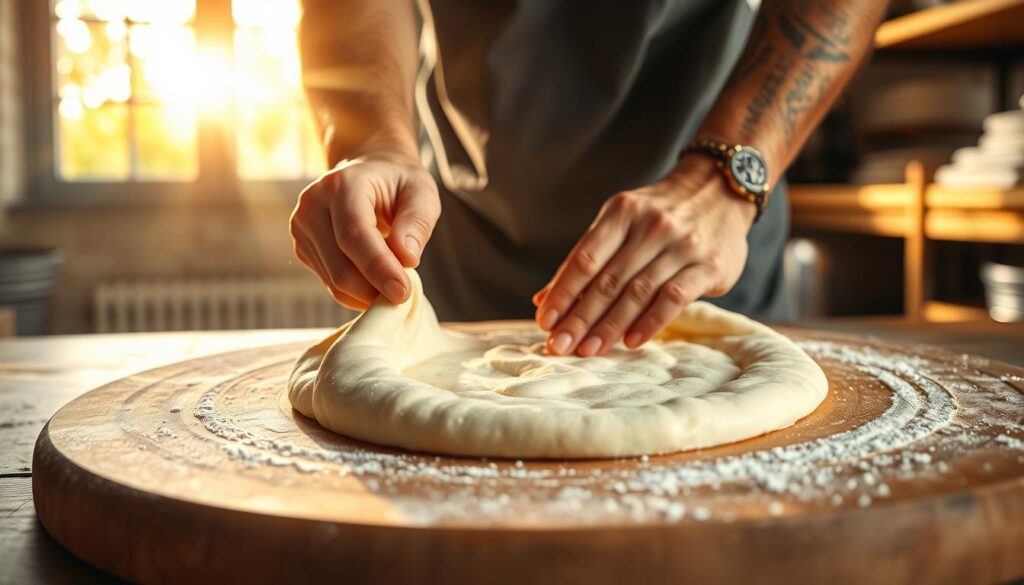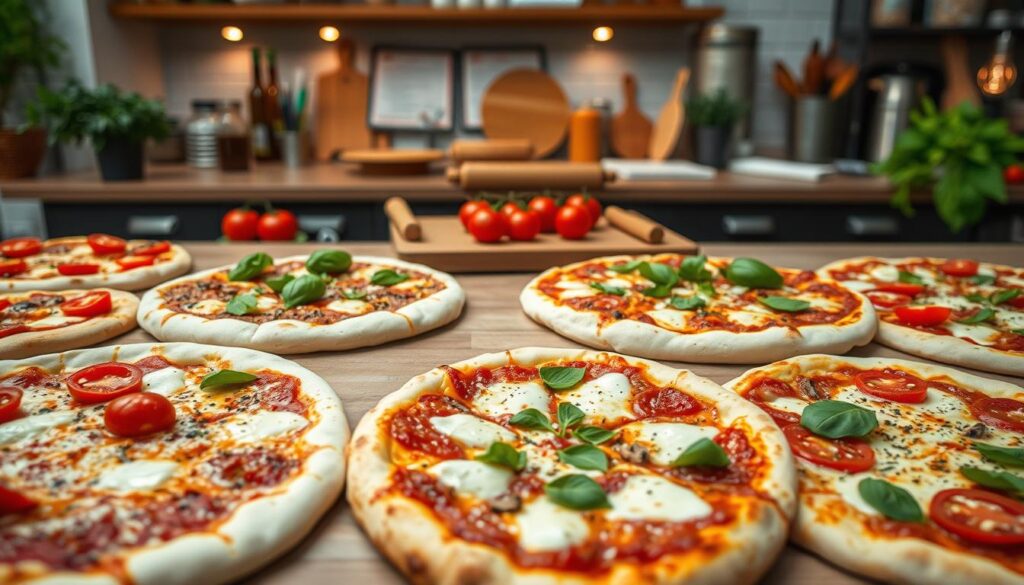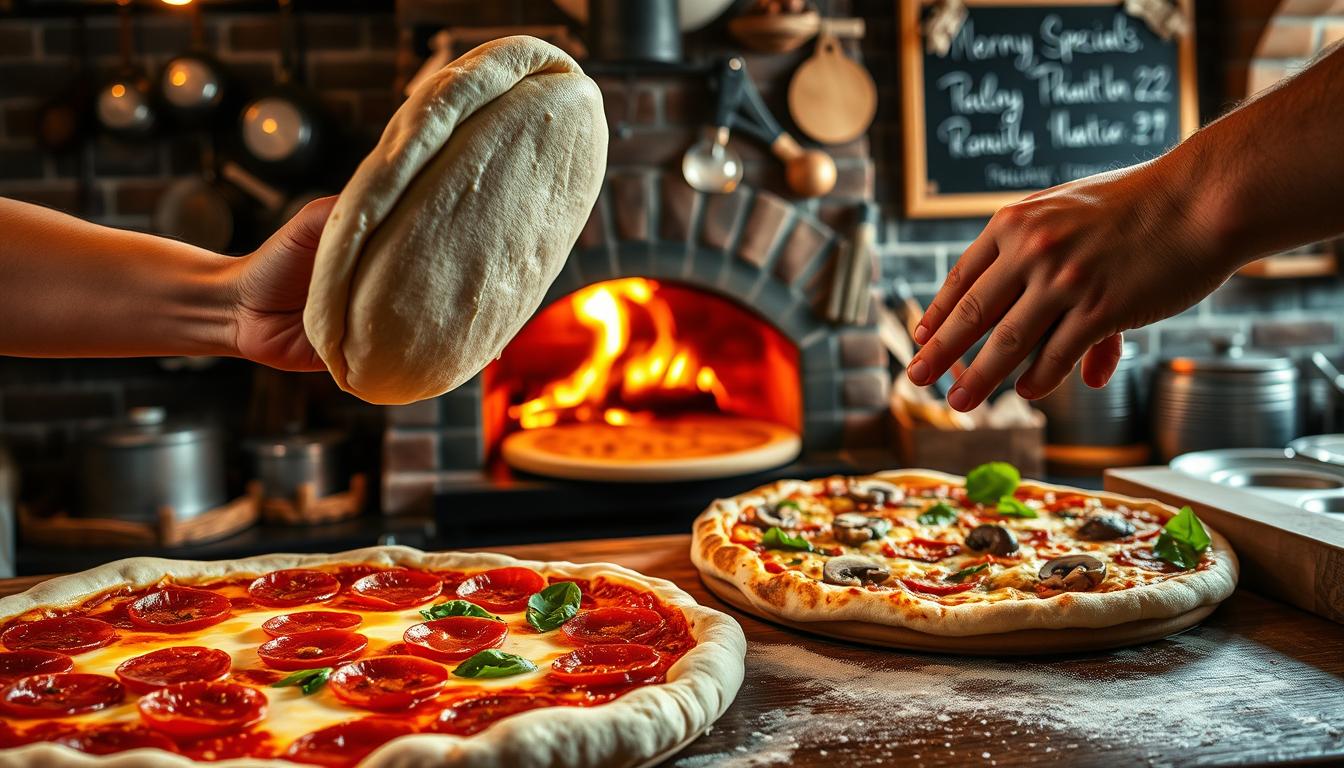Welcome to your ultimate guide on cooking pizza like a pro! Whether you’re a first-time baker or a seasoned home cook, this guide will transform your pizza-making skills. Learn how to craft delicious, restaurant-quality pizzas right in your kitchen. From mastering the dough to perfecting your pizza recipes, we’ve got you covered.
Let’s get started on your journey to creating mouthwatering pizzas that everyone will love!
Key Takeaways
- Master the basics of cooking pizza for perfect results every time.
- Discover essential tips for selecting and preparing ingredients.
- Learn professional techniques to elevate your pizza recipes.
- Understand the importance of equipment and temperature control.
- Explore creative variations to make your pizza truly unique.
The Essential Elements of Perfect Pizza Making
When it comes to making a perfect pizza, there are several essential elements that come into play. From the type of pizza dough used to the variety of pizza toppings chosen, every detail matters. Understanding these elements is crucial to creating a delicious and authentic pizza that will impress even the most discerning palates.
A great pizza starts with a solid foundation, which is the pizza dough. The type of flour used, the ratio of water to flour, and the proofing time all contribute to the final texture and flavor of the crust. Toppings, on the other hand, can range from classic combinations like mozzarella and tomato sauce to more adventurous options like pineapple and prosciutto.
Here are some key considerations for perfect pizza making:
- Choose a high-quality pizza dough that is made with fresh ingredients and has a good balance of crunch and chew.
- Select a variety of pizza toppings that complement each other in terms of flavor and texture.
- Consider the cooking method and temperature to ensure that the crust is crispy and the toppings are cooked to perfection.
By focusing on these essential elements and paying attention to detail, you can create a truly exceptional pizza that will satisfy your cravings and impress your friends and family.
Mastering Your Pizza Dough
To create the perfect pizza, you need to start with a great pizza dough. This is the foundation of your pizza, and it can make or break the final product. When making pizza recipes, it’s essential to use high-quality ingredients and follow a tried-and-true process.
Here are some tips for mastering your pizza dough:
- Use the right type of flour, such as bread flour or all-purpose flour, to create a dough that is both strong and tender.
- Make sure to knead the dough long enough to develop the gluten, which will give your crust its chewy texture.
- Let the dough rest for a sufficient amount of time to allow the yeast to ferment and the dough to rise.
By following these tips and practicing your skills, you can create a delicious and authentic pizza dough that will elevate your pizza recipes to the next level. Remember to always use fresh ingredients and to experiment with different toppings and flavor combinations to find your perfect pie.
Choosing the Right Equipment for Cooking Pizza
When it comes to cooking pizza, having the right equipment can make all the difference in the quality of your final product. Whether you’re a seasoned pro or just starting out, investing in the right pizza equipment can help you achieve the perfect crust, melt, and flavor. From pizza stones to steel, and from traditional ovens to specialized pizza ovens, the options can be overwhelming. In this section, we’ll explore the essential tools and accessories you’ll need to get started with cooking delicious pizza, including the best equipment for working with pizza dough.
To start, let’s consider the basics of pizza equipment. Some key items to consider include:
- A high-quality oven that can reach high temperatures
- A pizza stone or steel for cooking and crisping the crust
- A pizza peel for transferring the dough to the oven
- A set of utensils, such as a pizza cutter and serving spatula
When working with pizza dough, it’s essential to have the right equipment to help you shape, top, and cook your pizzas to perfection. With the right pizza equipment, you’ll be well on your way to creating delicious, authentic pizzas that will impress your friends and family.
Selection and Preparation of Pizza Toppings
When it comes to creating delicious pizza recipes, the toppings are a crucial element. Fresh ingredients can make all the difference in the flavor and texture of your pizza. To select the best pizza toppings, consider the flavor profile you want to achieve and the ingredients that will complement it. You can find inspiration for unique pizza recipes at pizza cooking websites that offer a variety of pizza recipes and topping combinations.
Some popular pizza toppings include cheese, tomato sauce, and various meats or vegetables. The key to creating a great pizza is to balance the flavors and textures of the toppings. You can use a combination of classic toppings or get creative with unique ingredients like fresh herbs or spicy peppers. Here are some tips for preparing pizza toppings:
- Choose fresh, high-quality ingredients
- Prepare toppings in advance to ensure they are ready to use
- Balance flavors and textures to create a harmonious combination
By following these tips and experimenting with different pizza toppings and recipes, you can create delicious and unique pizzas that will impress your family and friends. Remember to have fun and be creative with your pizza recipes, and don’t be afraid to try new ingredients and combinations.
The Science Behind Perfect Pizza Sauce
When it comes to creating the perfect pizza, the sauce is a crucial component. A great pizza sauce can elevate the entire dish, while a subpar sauce can bring it down. In this section, we’ll delve into the world of pizza sauce, exploring the science behind what makes a great sauce and providing tips for creating your own delicious pizza sauce at home.
At its core, pizza sauce is a simple combination of ingredients, including crushed tomatoes, garlic, olive oil, and herbs. However, the key to a great sauce lies in the balance of these ingredients and the way they’re prepared. Classic tomato sauce recipes often involve cooking the sauce for an extended period to reduce the liquid and intensify the flavors.
Some popular pizza sauce options include:
- Neapolitan-style sauce, made with San Marzano tomatoes and a touch of sugar
- Arrabbiata sauce, a spicy sauce made with crushed tomatoes and red pepper flakes
- Pesto sauce, a creamy sauce made with basil, garlic, and olive oil
When it comes to applying the sauce to your pizza, the technique is just as important as the sauce itself. A good rule of thumb is to apply a thin, even layer of sauce, leaving a small border around the edges of the crust. This will help prevent the sauce from overflowing and creating a mess.
For those looking to experiment with new pizza recipes, consider trying out different sauce options, such as a white sauce made with garlic and olive oil or a BBQ sauce made with tomato sauce and spices. The possibilities are endless, and with a little practice, you can create your own unique pizza sauce recipes at home.
By mastering the art of pizza sauce, you’ll be well on your way to creating delicious, authentic pizzas that are sure to impress your friends and family. Whether you’re a seasoned pro or just starting out, the key to a great pizza sauce is experimentation and practice, so don’t be afraid to try new things and adjust your recipe to suit your tastes.
Professional Techniques for Stretching Dough
To create the perfect crust, mastering the art of stretching pizza dough is essential. With the right techniques, you can achieve the ideal shape, thickness, and texture for your pizza recipes. Whether you’re working with traditional or unique variations, these professional tips will help you master this crucial skill.
When stretching pizza dough, it’s crucial to maintain a consistent temperature and humidity level. This will help the dough relax and become more pliable, making it easier to shape and stretch. To achieve the perfect crust, follow these steps:
- Start by gently stretching the dough from the center outwards, using your fingertips to guide it.
- Use a gentle, sweeping motion to stretch the dough, working your way around the circumference.
- As you stretch, rotate the dough to maintain evenness and prevent it from becoming misshapen.
By following these professional techniques, you’ll be able to create a perfectly stretched crust for your pizza recipes. Remember to always handle the pizza dough gently and with care, as overworking it can lead to a tough, dense crust.

With practice and patience, you’ll become a master at stretching pizza dough and creating delicious, authentic pizza recipes that will impress your friends and family. So, get stretching and start creating your own perfect pies!
Temperature Control and Cooking Methods
Cooking pizza is an art that requires precision and attention to detail, especially when it comes to temperature control and cooking methods. To achieve the perfect bake, it’s essential to understand the different types of ovens and how to manage temperature for optimal results. Whether you’re using a traditional oven, a pizza stone, or a specialized pizza oven, the right pizza equipment can make all the difference.
When working with pizza dough, it’s crucial to consider the cooking time and temperature to prevent overcooking or undercooking. Here are some general guidelines to keep in mind:
- Preheat your oven to the right temperature (usually between 450-500°F) for at least 30 minutes before cooking.
- Use a pizza stone or baking steel to enhance crust crispiness and flavor.
- Cook your pizza for 10-15 minutes, or until the crust is golden brown and the cheese is melted and bubbly.
By following these guidelines and using the right pizza equipment, you’ll be well on your way to creating delicious, perfectly cooked pizzas that will impress your friends and family. Remember to always keep an eye on your pizza while it’s cooking, and don’t be afraid to experiment with different temperatures and cooking times to find your perfect combination.
| Oven Type | Temperature Range | Cooking Time |
|---|---|---|
| Traditional Oven | 425-475°F | 12-15 minutes |
| Pizza Stone | 450-500°F | 10-12 minutes |
| Specialized Pizza Oven | 500-550°F | 8-10 minutes |
Common Pizza Making Mistakes to Avoid
When making pizza, it’s easy to fall into common traps that can affect the quality of your pizza. To avoid these mistakes, it’s essential to understand the basics of pizza making, including the importance of proper dough preparation and the right pizza recipes. One common mistake is overloading your pizza with pizza toppings, which can make the crust soggy and unappetizing.
Here are some common mistakes to avoid:
- Not letting your dough rest properly, which can result in a dense and tough crust
- Using low-quality ingredients, such as low-moisture cheese or canned sauce
- Not preheating your oven to the right temperature, which can affect the cooking time and crust texture
By avoiding these common mistakes, you can create delicious and authentic pizzas with the right balance of pizza toppings and flavors. Remember to experiment with different pizza recipes and techniques to find your signature style.
With practice and patience, you can master the art of pizza making and create mouth-watering pizzas that will impress your friends and family. So, don’t be afraid to try new pizza recipes and experiment with different pizza toppings to find your favorite combinations.
Advanced Pizza Recipes and Variations
Once you’ve mastered the basics of pizza making, it’s time to experiment with advanced pizza recipes and variations. This is where you can let your creativity shine and try out new and exciting combinations of pizza toppings and specialty dough types.
With a little practice and patience, you can create unique and delicious pizza recipes that will impress your friends and family. From classic margherita to gourmet combinations, the possibilities are endless. You can also explore international pizza styles, such as Neapolitan or Sicilian, to add some variety to your pizza making.

Specialty Dough Types
One way to take your pizza making to the next level is to experiment with specialty dough types, such as gluten-free or whole wheat. These dough types can add a new dimension of flavor and texture to your pizzas.
Gourmet Topping Combinations
Another way to elevate your pizza making is to try out gourmet topping combinations, such as prosciutto and arugula or caramelized onions and blue cheese. These combinations can add a level of sophistication and elegance to your pizzas.
International Pizza Styles
Finally, you can explore international pizza styles, such as Italian or Greek, to add some variety to your pizza making. These styles can inspire new and exciting combinations of pizza toppings and specialty dough types.
Pizza Storage and Reheating Tips
Proper pizza storage is key to preserving the flavor and texture of your favorite dish. Whether you’re saving leftovers or prepping for a future meal, knowing how to store and reheat pizza can make all the difference. Here’s how to keep your pizza tasting fresh and delicious.
When it comes to pizza storage, start by letting your pizza cool completely before storing. This prevents condensation, which can make the crust soggy. Use an airtight container or wrap it tightly in foil and plastic wrap. For longer storage, place it in the freezer, where it can stay for up to 2 months.
Reheating pizza can be tricky, but with the right pizza equipment, it’s easy to achieve that fresh-out-of-the-oven taste. Preheat your oven to 350°F (175°C) and bake for 10-15 minutes. For a crispy crust, place it directly on the oven rack or use a baking sheet. If you’re reheating frozen pizza, add a few extra minutes to ensure it’s fully cooked.
Here are some quick tips for perfect pizza reheating:
- Use a preheated oven for even heating
- Add a splash of water to the oven for a crispy crust
- Reheat slices individually to prevent sogginess
- Experiment with different pizza equipment like pizza stones or steel for better results
With these simple steps, you can enjoy delicious pizza anytime, whether it’s fresh from the oven or reheated to perfection. Remember, the right pizza storage and reheating techniques can elevate your pizza game, making every bite as satisfying as the first.
| Storage Method | Reheating Time | Best Equipment |
|---|---|---|
| Refrigerator | 10-15 minutes | Oven |
| Freezer | 15-20 minutes | Baking sheet |
| Room temperature | 5-7 minutes | Pizza stone |
For more tips on enjoying pizza, check out how to order tasty pizza online for your next gathering.
Taking Your Pizza Making to the Next Level
As you continue to hone your pizza-making skills, it’s essential to explore new techniques and ideas to elevate your craft. One way to do this is by experimenting with different pizza recipes and unique pizza toppings to create signature styles that reflect your taste and creativity.
To take your pizza making to the next level, consider the following tips:
- Invest in a pizza stone or steel to improve crust texture and flavor
- Experiment with different pizza toppings combinations to find your favorite
- Practice making different types of pizza dough, such as Neapolitan or Sicilian
By following these tips and continuing to practice and experiment, you can create delicious and unique pizzas that will impress your friends and family. Whether you’re looking to start a home pizza business or simply want to elevate your cooking skills, the key is to have fun and be creative with your pizza recipes and toppings.
Here’s an example of a unique pizza recipe you can try:
| Pizza Type | Toppings | Cooking Time |
|---|---|---|
| Margherita | Tomato sauce, mozzarella, basil | 12-15 minutes |
| Meat Lover’s | Pepperoni, sausage, bacon, mozzarella | 15-18 minutes |
Conclusion: Your Journey to Pizza Perfection
As you reach the end of your journey into the world of cooking pizza, take a moment to savor the knowledge and skills you’ve acquired. From understanding the fundamentals of pizza dough to mastering the art of topping selection and preparation, you now possess the tools to create restaurant-quality pizza recipes in your own kitchen.
Remember, the beauty of pizza making lies in the freedom to experiment and develop your own unique style. Embrace the creative process, try new ingredient combinations, and find the techniques that work best for you. With dedication and practice, you’ll soon be impressing family and friends with your mouthwatering pizzas that rival the best in the industry.
As you continue your pizza perfection journey, stay curious, learn from your experiences, and never stop honing your craft. The world of pizza-making is vast and ever-evolving, so keep an open mind and be ready to adapt and grow. Savor every bite, share your creations, and inspire others to join you on this delicious adventure.
